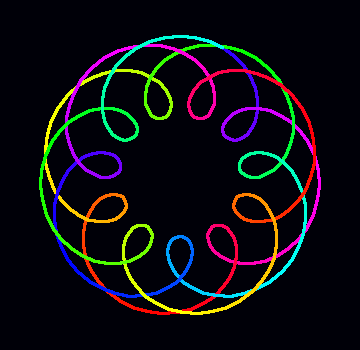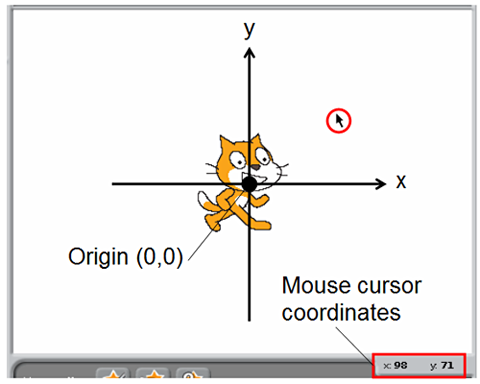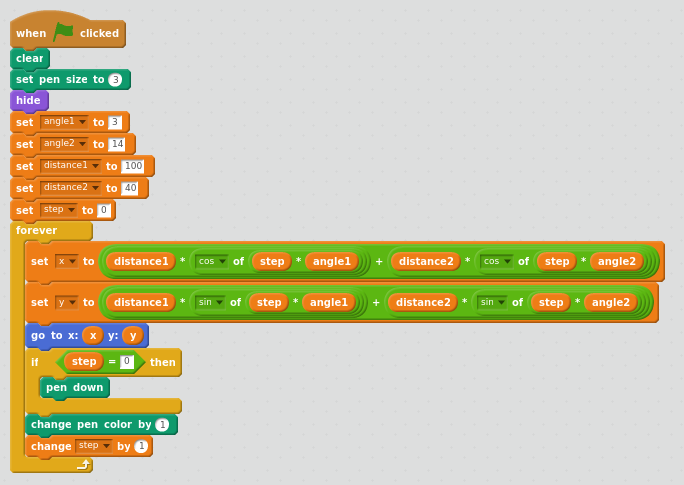Abstract
Have you ever used a toy like a Spirograph® to draw precise, repeatable patterns on a piece of paper? What if you could use a computer to automatically draw the patterns for you? This project will show you how to do just that using a Raspberry Pi. Check out the video to see what this simple, but fun, project looks like:Summary

Introduction
A Raspberry Pi (Figure 1) is a tiny computer that you can use to write programs and build and control your own electronic circuits, like the button circuit in this project. The circuit uses sensors to gather information from the world around it. You can use information from those sensors to tell your computer program what to do. Many electronic devices we use every day, like phones and video game controllers, use sensors in the same way.
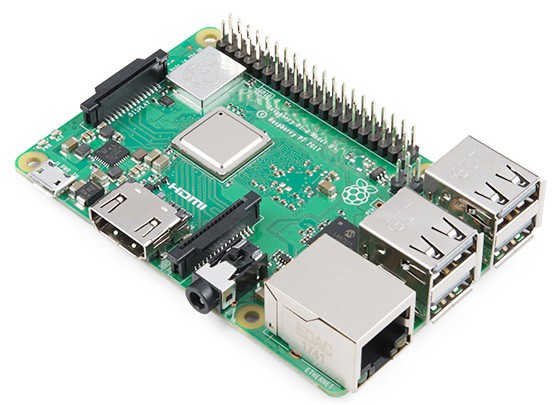 Image Credit: SparkFun Electronics / Creative Commons Attribution 2.0
Image Credit: SparkFun Electronics / Creative Commons Attribution 2.0
Figure 1. A Raspberry Pi computer. (Image credit SparkFun Electronics, licensed under Creative Commons Attribution 2.0).
You can do this project just for fun, or turn it into an engineering or science project. To make it an engineering project, you will need to follow the engineering design process. Start by defining what you want your program to be able to do, then work through the rest of the design process until you have a completed project to show off at your science fair.
If you want to use this for a science project, you will need to follow the scientific method. Start by coming up with a question for which you can use the patterns as a tool to help answer. For example, can you make patterns that create an optical illusion of some sort, and see how people react to them?
Bibliography
- Raspberry Pi Foundation (n.d.). Teach, Learn, and Make with Raspberry Pi - Raspberry Pi. Retrieved August 28, 2019.
- jimblom (n.d.). Switch Basics. SparkFun Electronics. Retrieved August 28, 2019.
- Science Buddies (n.d.). Raspberry Pi Setup. Retrieved August 28, 2019.
Materials and Equipment
If you already have access to a Raspberry Pi, read through the Procedure to see the additional parts you will need to build the circuit.
Experimental Procedure
Introduction
Have you ever been interested in computer graphics? What about the animated characters in video games or movies? This project will give you a simple introduction to drawing 2D graphics using Scratch. If you have not already, you will need to set up your Raspberry Pi before you begin. Watch the video below to see several different designs:
Drawing a Simple Shape
If you have never written a program in Scratch before, watch this video to learn how:
To begin, you will make a program that will automatically draw a certain shape. Think about what motions you would make with your hand if you wanted to draw a simple shape, like a square. You would need to put your pen down on a piece of paper and draw four lines.
You can draw shapes in Scratch using the Pen menu, which contains the pen down block. Enter the following program and see what happens when you run it:
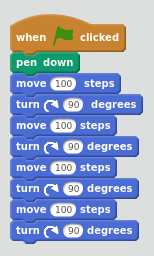 Image Credit
Image Credit
Figure 2
The program should make your cat sprite move around the stage and draw a square, like this:
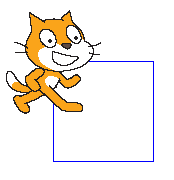 Image Credit
Image Credit
Figure 3
You can make the program a little less cluttered by using variables and loops, instead of repeating the same code four times. Try entering this code in a new program:
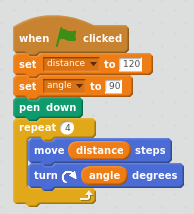 Image Credit
Image Credit
Figure 4
Now, it is easy to change the size of your square by changing thedistance variable. There is just one problem, if you change distance and run the program again, your previous square will still be on the screen.
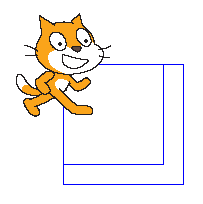 Image Credit: Science Buddies
Image Credit: Science Buddies
Figure 5
You can fix this by using the clear block (under Pen) at the beginning of your program, which erases anything previously drawn by the pen. You can also use the hide block (under Looks) to make the cat sprite invisible, so it does not clutter up your drawing (remember that each sprite has its own Scripts tab, so if you add more sprites, each one will need its own hide block). Finally, if the cat is moving too fast for you to see and you want to slow it down, you can add a wait block inside the loop.
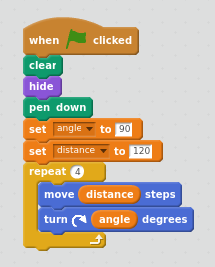 Image Credit: Science Buddies
Image Credit: Science Buddies
Figure 6
Now, each time you run the program, you should just see a single blue square on your stage. You will also see the angle and distance variables in the upper-left corner, but you can decide to hide them later.
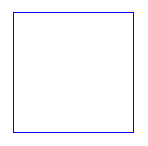 Image Credit
Image Credit
Figure 7
What if you want to create a shape with a different number of sides, like a triangle or a pentagon? It would be annoying to figure out the angle you need to use for each new shape in your program, and change the number of loops. Luckily, you can write a clever program that will do this automatically. All you have to do in the following program is change the number_of_sides variable to draw a new shape. You might want to save your previous program and start a new one, since this program has a different purpose.
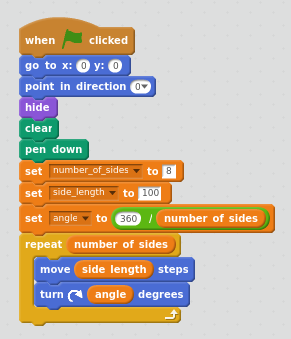 Image Credit: Science Buddies
Image Credit: Science Buddies
Figure 8
Try entering the program above and running it with different values for number_of_sides. Can you use the program to draw different shapes?
Change How it Looks
You might think your drawings look a little boring with just a plain blue pen on a white background. It can also be annoying to have the variables that automatically display on the stage clutter up your drawing area. This section will explain how you can make your drawing more colorful!
To get rid of the variables on stage, you can add the hide variable ____ block at the beginning of your code, or uncheck the checkbox next to the variable's name in the Data menu.
To change the background, use the buttons under Stage near the Sprites area on your screen. From left to right, the buttons will allow you to choose an image from the existing Scratch library, draw a new image, upload an image from your computer, or take a new picture with your computer's camera.
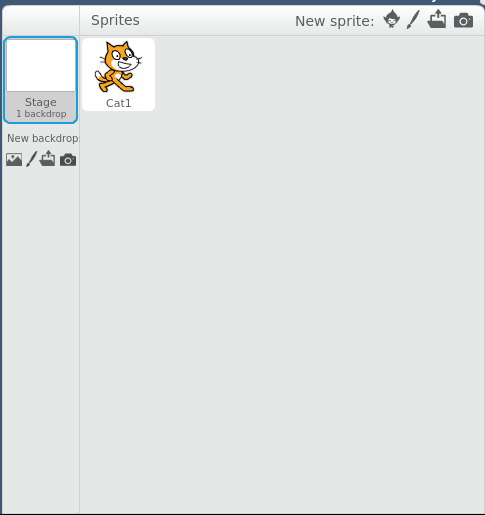 Image Credit: Science Buddies
Image Credit: Science Buddies
Figure 9
You can change the appearance of the pen using various blocks in the Pen menu. For example, here is a program that will draw each side of the shape in a different color.
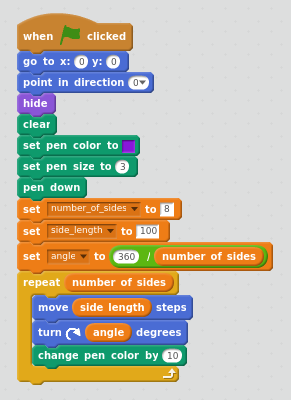 Image Credit: Science Buddies
Image Credit: Science Buddies
Figure 10
Try experimenting with different pen sizes, pen colors, and background colors to decide what you think looks best. Remember to save your program!
Making a Pattern
Now that you are familiar with the basics of controlling the pen, you can try creating more-advanced patterns. For example, what happens if you draw a whole bunch of shapes, but rotate each new shape a little bit from the previous one? The program below will result in multiple drawn polygons, each new one rotated by angle2 degrees. Create a new program to try it out.
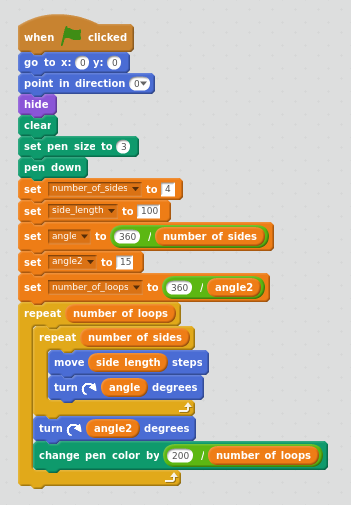 Image Credit: Science Buddies
Image Credit: Science Buddies
Figure 11
With the variable values in the screenshot above, the program creates this rainbow-colored pattern of squares:
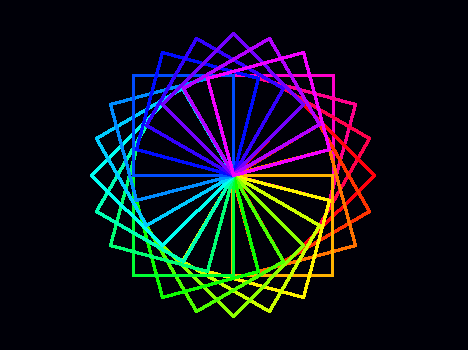 Image Credit: Science Buddies
Image Credit: Science Buddies
Figure 12
Try entering the program above and playing around with different values for the variables to see what types of patterns you can create. Or, alter the program even further by adding additional move and turn commands to make more-complex shapes. Do not be afraid to experiment and try new things!
Making Your Pattern Interactive
So far, your drawing is not interactive at all. You click the green flag and your program runs on its own. What if you add buttons to change the pattern as it is drawing? You can do this by putting buttons on your breadboard, just like in the Design Your Own Video Game with a Raspberry Pi project. To build your circuit, you will need to use a breadboard. If you have not used a breadboard before, watch this video before you continue:
To build the circuit, you will just need jumper wires and the two pushbuttons:
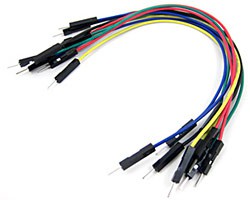 Image Credit: Science Buddies Image Credit: Science Buddies
Figure 13 |
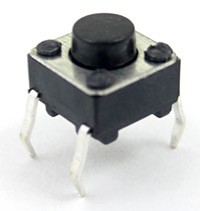 Image Credit: Science Buddies Image Credit: Science Buddies
Figure 14 |
Follow the directions below to assemble the circuit. Note that the buttons each have four pins.
| Part | Picture Reference | First Hole | Second Hole |
|---|---|---|---|
| Black M-M jumper wire |  Image Credit: Science Buddies Image Credit: Science Buddies
|
J17 (Pi Wedge GND) | Ground bus (right side) |
| Blue M-M jumper wire |  Image Credit: Science Buddies Image Credit: Science Buddies
|
J22 | Ground bus (right side) |
| Blue M-M jumper wire |  Image Credit: Science Buddies Image Credit: Science Buddies
|
J27 | Ground bus (right side) |
| Red M-M jumper wire |  Image Credit: Science Buddies Image Credit: Science Buddies
|
J20 | A7 (Pi Wedge G4) |
| Green M-M jumper wire |  Image Credit: Science Buddies Image Credit: Science Buddies
|
J25 | A8 (Pi Wedge CE1) |
| Pushbutton |  Image Credit: Science Buddies Image Credit: Science Buddies
|
E20 E22 |
F20 F22 |
| Pushbutton |  Image Credit: Science Buddies Image Credit: Science Buddies
|
E25 E27 |
F25 F27 |
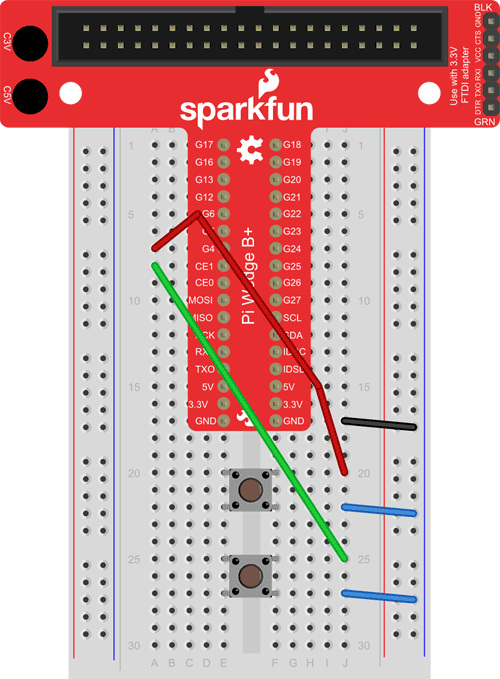 Image Credit: Science Buddies
Image Credit: Science Buddies
Figure 15
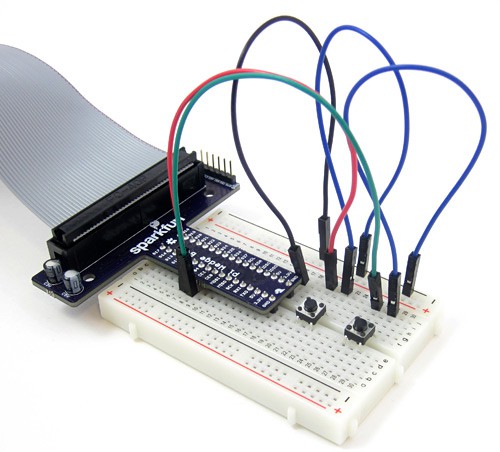 Image Credit: Science Buddies
Image Credit: Science Buddies
Figure 16
Now, modify your Scratch code to use button presses to change one of the variables in your program. The example below uses the buttons to increase or decrease the number of sides of the polygons. What happens if you run the program and push the buttons while the pattern is being drawn?
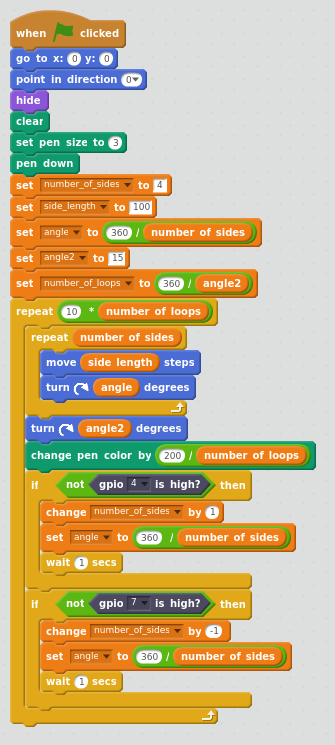 Image Credit: Science Buddies
Image Credit: Science Buddies
Figure 17
Advanced: Making a Spirograph
If you are ready for an even more advanced design, you can try making a spirograph. The code to make a spirograph can get pretty complicated, so be careful! Try entering the program below, then running it with different values for the angle1, angle2, distance1, and distance2 and variables. Changing the values can result in drastically different spirograph patterns.
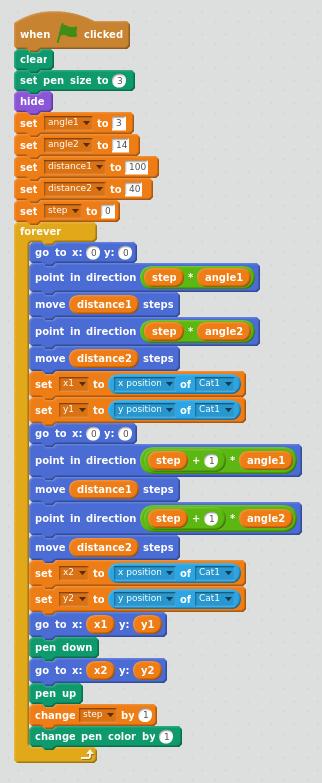 Image Credit: Science Buddies
Image Credit: Science Buddies
Figure 18
The values in the screenshot above should result in a spirograph like this:
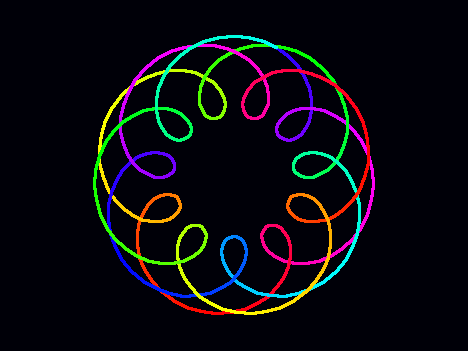 Image Credit: Science Buddies
Image Credit: Science Buddies
Figure 19
Try tweaking the variables or making your own edits to the code. How many different spirograph designs can you create?
Going Further
Here are some ideas for you to continue exploring with creating your own graphics:
- In this project, you wrote several programs that control the pen to automatically draw shapes. What about letting the user control the pen, perhaps with the arrow keys or the mouse? Can you make your own simple drawing program?
- Can you use multiple inputs (from your keyboard and/or breadboard) to change different variables in the spirograph or pattern as it draws?
- What about using other sensors that came with your kit, like the magnet, motion, or light sensors? See the other projects in your kit to learn how to use the other sensors.
Troubleshooting
For troubleshooting tips, please read our FAQ: Draw a Spirograph with a Raspberry Pi.
Ask an Expert
Global Connections
The United Nations Sustainable Development Goals (UNSDGs) are a blueprint to achieve a better and more sustainable future for all.
Frequently Asked Questions (FAQ)
Kit General Questions
- Who is the kit appropriate for?
- Are the kit parts reusable?
- Aren't there other Raspberry Pi kits on the market? How is yours different?
- I already have a Raspberry Pi. Can I just buy the circuit parts separately?
- What programming language do the projects use?
Setting Up and Using Your Raspberry Pi FAQ
- How do I connect my Raspberry Pi to my TV or computer monitor?
- Can I use a laptop as a display and/or keyboard?
- How do I connect my Raspberry Pi to the internet?
- How do I shut down or reboot my Raspberry Pi? There's no power button!
- How can I adjust the Raspberry Pi's display resolution?
- I have everything connected properly, why can't I hear any sound?
- Why won't my Raspberry Pi turn on?
- My Raspberry Pi starts to boot up, but then it freezes or the screen goes blank. What is wrong?
- My Raspberry Pi froze and is not responding to mouse or keyboard input. What should I do?
- My Raspberry Pi is acting strangely (it suddenly will not boot up properly, certain programs do not work, etcetera). What is wrong?
- I think I corrupted my Raspberry Pi's SD card. What should I do?
- I need help with a question, related to my Science Buddies Raspberry Pi Projects Kit or Raspberry Pi Circuits Parts Only Kit, not listed here. Who can I ask?
Kit General Answers
Q: Who is the kit appropriate for?A: The kit is meant for anyone (ages 8 and up) who wants to learn some basic programming and electronics skills while having fun. Students up to age 10, or older if their reading skills are behind grade level, may need adult assistance in reading and following the on-screen instructions. The projects included in the kit were beta tested and approved by students ages 8 to 16.
Q: Are the kit parts reusable?
A: Yes, all the electronics components in the kit can be re-used to do new projects or to repeat the projects.
Q: Aren't there other Raspberry Pi kits on the market? How is yours different?
A: Yes, there are other Raspberry Pi kits, and some of them are quite good! The Raspberry Pi Projects Kit and Raspberry Pi Circuit Parts Only Kit have been designed to contain the specific materials needed to do the accompanying Science Buddies Raspberry Pi projects. Our kit and associated projects are specifically meant for people who have no prior experience programming or connecting circuits. The projects are 100% beginner friendly with clear on-screen instructions, pictures, and videos. We think the kit, with its associated projects, is one of the most fun kits out there! But, if you are already an ace programmer or electronics guru, you may not find this the best fit for your own personal use. Even so, it may be a fun way for you to introduce others to programming and electronics.
Q: I already have a Raspberry Pi. Can I just buy the circuit parts separately?
A: Yes! We sell two different kits: the Raspberry Pi Projects Kit which includes a Raspberry Pi and the required accessories, and the Raspberry Pi Circuit Parts Only Kit, which only contains the additional circuit parts you need to do the Science Buddies projects. Both kits contain an SD card with the Raspbian operating system and a desktop shortcut to the Science Buddies project instructions.
Q: What programming language do the projects use?
A: The projects use Scratch 2. Scratch is a "graphical" programming language developed by the MIT Media Lab. It allows you to write code by clicking, dragging, and snapping together color-coded blocks. This allows beginners to write working code without worrying about formatting or typos. On the Raspberry Pi, Scratch allows you to control the general purpose input and output (GPIO) pins so your program can interact with a circuit in the physical world.
Note: three different versions of Scratch (1, 2, and 3) are available for the Raspberry Pi. The instructions for the Science Buddies projects (including example code) are specifically written for Scratch 2, which runs well on the Raspberry Pi model 3B+. If you have an older model Raspberry Pi, Scratch 2 may run more slowly, or may not run at all. If you want to use a different version of Scratch, you will need to consult the official documentation for Scratch 1.4 or Scratch 3 and modify the programming steps accordingly.
Setting Up and Using Your Raspberry Pi FAQ Answers
Q: How do I connect my Raspberry Pi to my TV or computer monitor?A: The easiest way to set up your Raspberry Pi is to use an HDMI cable (included in the Science Buddies Raspberry Pi Projects Kit) to connect to a TV or computer monitor that has built-in speakers. If you are using a computer monitor with an HDMI port but no built-in speakers, you will also need separate speakers or headphones with a 3.5 mm audio plug (a regular "headphone jack").
If your TV or monitor does not have an HDMI port, you will need an HDMI to DVI or HDMI to VGA adapter (see pictures in table below). DVI and VGA do not transmit sound, so you will need separate headphones or speakers if you are using one of those options.
| HDMI | DVI | VGA |
|---|---|---|
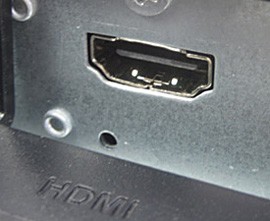 Image Credit: Ben Finio, Science Buddies / Science Buddies Image Credit: Ben Finio, Science Buddies / Science Buddies
|
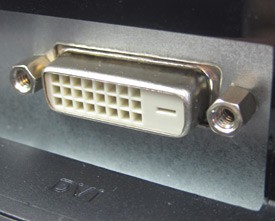 Image Credit: Ben Finio, Science Buddies / Science Buddies Image Credit: Ben Finio, Science Buddies / Science Buddies
|
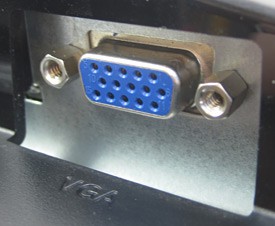 Image Credit: Ben Finio, Science Buddies / Science Buddies Image Credit: Ben Finio, Science Buddies / Science Buddies
|
Q: Can I use a laptop as a display and/or keyboard?
A: The short answer is "not easily." Many newer laptops have HDMI ports, but they only function as HDMI out, to send a video signal from the laptop to a television or projector. They do not work as HDMI in to display an external signal on the laptop's screen. The laptop's keyboard is only designed to work with the laptop itself, not as a standalone keyboard for an external device like the Raspberry Pi.
The longer answer is that, similar to the Remote Desktop feature on Windows and Mac computers, you can use special software to remotely operate a Raspberry Pi that is connected to the internet. This would allow you to control a Raspberry Pi using your laptop's screen and keyboard. This option is only recommended for advanced users, and you can find instructions at Raspberry Pi Documentation.
Q: How do I connect my Raspberry Pi to the internet?
A: Unlike earlier models, the Raspberry Pi 3B+ contains built-in Wi-Fi functionality. It does not require an external USB Wi-Fi adapter. You can connect your Raspberry Pi to the internet by clicking the internet icon in the taskbar and searching for available Wi-Fi networks, just like you would on a Windows or Mac computer. Your Raspberry Pi also has an ethernet port, which you can use to plug directly into a router for a hardwired connection.
Q: How do I shut down or reboot my Raspberry Pi? There's no power button!
A: Unlike most computers, the Raspberry Pi does not have a power button. You can shut down or reboot by clicking the raspberry icon in the upper left corner of your desktop, then select Shutdown. After the Raspberry Pi has shut down, it is safe to unplug the micro-USB power cable. Plug the cable back in to reboot. Important: never unplug the power cable while the Raspberry Pi is still running. This can corrupt the SD card.
Q: How can I adjust the Raspberry Pi's display resolution?
A: Click the Raspberry Pi logo in the top-left corner of your desktop. Select Preferences, then Raspberry Pi Configuration, then click the Set Resolution... button on the System tab.
Q: I have everything connected properly. Why can't I hear any sound?
A: Right-click the speaker icon on the desktop taskbar. This allows you to manually select HDMI or analog (the headphone jack) for sound output. Make sure you have the proper output selected. Also, make sure your Scratch program is set to play a sound. You can write a simple program to test if your sound is working using the "when space key pressed" and "play sound meow" blocks.
Q: Why won't my Raspberry Pi turn on?
A: If your Raspberry Pi will not turn on (the screen remains blank after everything is plugged in), go through this checklist to make sure everything is set up properly.
- Make sure your SD card is pushed in all the way (see Figure 1).
- Make sure the red power LED on your Raspberry Pi (labeled "PWR," near the micro-USB port, see Figure 2) is on. This means the Raspberry Pi is receiving power from the micro-USB port. If the LED is not on, make sure you pushed the micro-USB connector into the micro-USB port all the way.
- When you first plug the micro-USB cable in, the green LED (labeled "ACT," next to the PWR LED, see Figure 2) should flash several times. This LED flashes when the Raspberry Pi reads data from the SD card. After the Raspberry Pi is done booting up, it should turn off. If it does not flash at all, your SD card might not be inserted properly. Go back to step 1.
- Make sure your display (television or monitor) is turned on. If your display is turned off, you will not see anything on the screen, even if the Raspberry Pi is on.
- Make sure your display is set to the correct input. Many modern TVs have more than one HDMI input, and some computer monitors have DVI or VGA inputs in addition to HDMI.
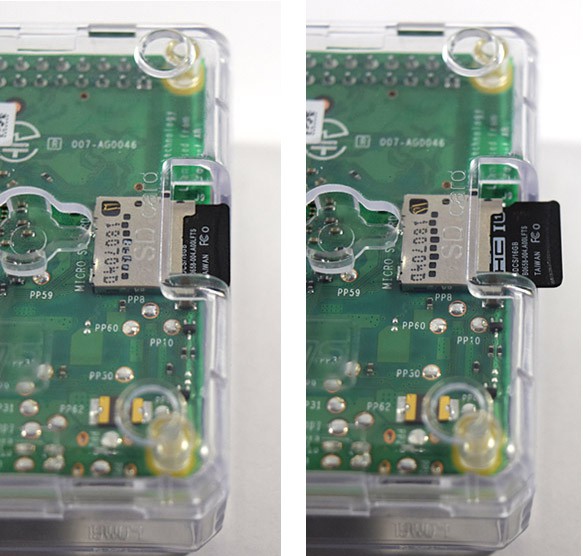 Image Credit: Ben Finio, Science Buddies / Science Buddies
Image Credit: Ben Finio, Science Buddies / Science Buddies
Figure 1. A micro-SD card that is inserted properly (left) and one that is not pushed in all the way (right).
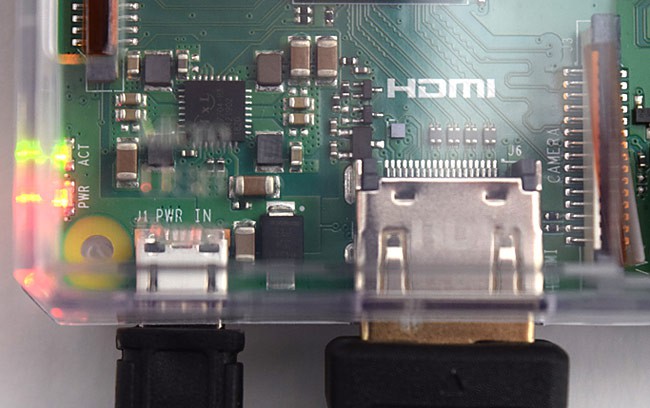 Image Credit: Ben Finio, Science Buddies / Science Buddies
Image Credit: Ben Finio, Science Buddies / Science Buddies
Figure 2. The PWR (red) and ACT (green) LEDs near the micro-USB port.
Q: My Raspberry Pi starts to boot up, but then it freezes or the screen goes blank. What is wrong?
A There may be a problem with your Raspberry Pi or SD card. If you are using the Raspberry Pi or SD card that came with the Raspberry Pi Projects Kit or Raspberry Pi Circuit Parts Only Kit purchased from our partner Home Science Tools, please contact them directly at service@homesciencetools.com for assistance.
Q: My Raspberry Pi froze and is not responding to mouse or keyboard input. What should I do?
A: First, be patient and give the Raspberry Pi a few minutes to try and process whatever it was doing. If you click on a whole bunch of things in rapid succession, or run a really complicated Scratch program, the Raspberry Pi might slow down or freeze temporarily.
Next, if you are using a wireless keyboard and mouse, make sure they have fresh batteries.
Finally, as a last resort, if your Raspberry Pi is not responding, unplug the micro-USB cable and plug it back in. In general, you want to avoid doing this, because suddenly cutting power to the Raspberry Pi without properly shutting it down first can corrupt the SD card, and prevent the Raspberry Pi from working properly.
Q: My Raspberry Pi is acting strangely (e.g. it suddenly will not boot up properly, certain programs do not work, etc.). What is wrong?
A: If your Raspberry Pi is not "dead," but seems to be behaving strangely, there is a chance that your SD card has become corrupted. This can happen if you unplug the Raspberry Pi's power cord without properly shutting it down first. See the next question.
Q: I think I corrupted my Raspberry Pi's SD card. What should I do?
A: If the SD card came with the Raspberry Pi Projects Kit or Raspberry Pi Circuit Parts Only Kit you purchased from our partner Home Science Tools, please contact them directly at service@homesciencetools.com for assistance. Make sure to include a detailed description of the problem you are having. They will work with you to resolve the issue.
Careers
If you like this project, you might enjoy exploring these related careers:
Related Links
- Science Fair Project Guide
- Other Ideas Like This
- Computer Science Project Ideas
- Pure Mathematics Project Ideas
- My Favorites



